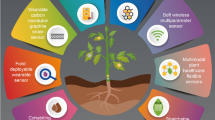Abstract
The use of wireless sensor network (WSN) is essential for gathering data and implementation of information and control technologies in precision agriculture. The efficiency of such smart system strongly depends on WSN reliability and durability, which is highly influenced by wireless channel. Relaying of the collected data over the intermediate nodes has been proven as a good strategy for WSNs. In this paper we assume amplify-and-forward relaying strategy with variable gain amplification. In order to improve system performance we propose implementation of polarization diversity. It is assumed that all communication links are influenced by Rician fading. Thus, in the case of polarization diversity, link between the source and the relay is characterized as two correlated and non-identical Rician fading channels. In this paper, we present a novel analytical model for determining the outage probability of such system, which is applicable to various fading scenarios described with different Rician K factors and average signal to noise ratios (SNR), as well as different level of diversity signals correlation and cross-polar discrimination. Numerical results show that, using polarization diversity, improvements for the considered system performance can be realized with significantly lower SNR, despite a certain level of correlation and power unbalance between the diversity branches. In that manner, compared to the system with no diversity, the total needed transmit power for achieving the same level of system performances is reduced, and thus more energy efficient communication is enabled.




Similar content being viewed by others
References
Sohraby, K., Minoli, D., & Znati, T. (2007). Wireless sensor networks: Technology, protocols, and applications. New York: Wiley.
Baggio, A. (2005). Wireless sensor networks in precision agriculture. In ACM Workshop on real-world wireless sensor networks.
Hasna, M. O., & Alouini, M.-S. (2003). A performance study of dual- transmissions with fixed gain relays. In Proceedings of IEEE international conference acoustics, speech, and signal processing (ICASSP03).
Karagiannidis, G. K. (2006). Performance bounds of multihop wireless communications with blind relays over generalized fading channels. IEEE Transactions on Wireless Communications, 5(3), 498–503.
Laneman, J. N., Tse, D. N. C., & Wornell, G. W. (2004). Cooperative diversity in wireless networks: Efficient protocols and outage behavior. IEEE Transactions on Information Theory, 50(12), 3062–3080.
Adinoyi, A., & Yanikomeroglu, H. (2007). Cooperative relaying in multi-antenna fixed relay networks. IEEE Transactions on Wireless Communications, 6(2), 533–544.
Bao, V. N. Q., Bac, D. H., Thuan, T. D., et al. (2011). Performance analysis of partial relay selection with multi-antenna destination cooperation. In IEEE International conference on ICT convergence (ICTC) (pp. 101–105).
Thang, L. T., Tuyen, L. P., & Bao, V. N. Q. (2012). Outage performance of multi-antenna cooperative incremental relaying systems in the absence of direct link. In IEEE 14th international conference advanced communication technology (ICACT) (pp. 783–787).
Fan, Y., & Thompson, J. (2007). MIMO configurations for relay channels: Theory and practice. IEEE Transactions on Wireless Communications, 6(5), 1774–1786.
Ilic-Delibasic, M., Pejanovic-Djurisic, M., & Prasad, R. (2012). A novel method for performance analysis of OFDM polarization diversity system in Ricean fading environment. Wireless Personal Communications, 63(3), 751–764.
Bahrami, H. -R., & Le-Ngoc, T. (2008). Maximum ratio combining precoding for multi-antenna relay systems. In IEEE international conference on communications (ICC) (pp. 820–824).
Lee, W. C. Y., & Yeh, Y. S. (1972). Polarization diversity system for mobile radio. IEEE Transactions on Communications, com-20(5), 912–923.
Jootar, J., & Zeidler, J. R. (2003). Performance analysis of polarization receive diversity in correlated Rayleigh fading channels. In Proceedings of IEEE Globecom conference (pp. 774–778).
Lukama, L. C., & Edvards, D. J. (2001). Performance of spatial and polarization diversity. In Proceedings of wireless personal multimedia communications (WPMC01), Aalborg, Denmark.
Simon, M. K., & Alouini, M.-S. (2005). Digital communication over fading channels (2nd ed.). New York: Wiley.
Hasna, M. O., & Alouini, M. S. (2003). End-to-end performance of transmission systems with relays over Rayleigh-fading channels. IEEE Transactions on Wireless Communications, 2(6), 1126–1131.
Ilic-Delibasic, M., & Pejanovic-Djurisic, M. (2013). MRC dual-diversity system over correlated and non-identical Ricean fading channels. IEEE Communications Letters, 17(12), 22802283.
Gradshteyn, I. S., & Ryzhik, I. M. (2007). Table of integrals, series and products. San Diego, CA: Academic Press.
Delibasic, M., & Pejanovic-Djurisic, M. (2014). Dual-hop amplify-and-forward relay system over non-identical Ricean fading channels. Wireless Personal Communications, 1–12.
Acknowledgments
This research is supported by REGPOT project Fostering innovation based research for e-Montenegro (Fore-Mont) and the HERIC project through the BIO-ICT Centre of Excellence (Contract No. 01-1001).
Author information
Authors and Affiliations
Corresponding author
Rights and permissions
About this article
Cite this article
Delibasic, M., Pejanovic-Djurisic, M. Performance Improvement Using Polarization Diversity in Precise Agriculture Communication Platform. Wireless Pers Commun 92, 169–179 (2017). https://doi.org/10.1007/s11277-016-3844-1
Published:
Issue Date:
DOI: https://doi.org/10.1007/s11277-016-3844-1




